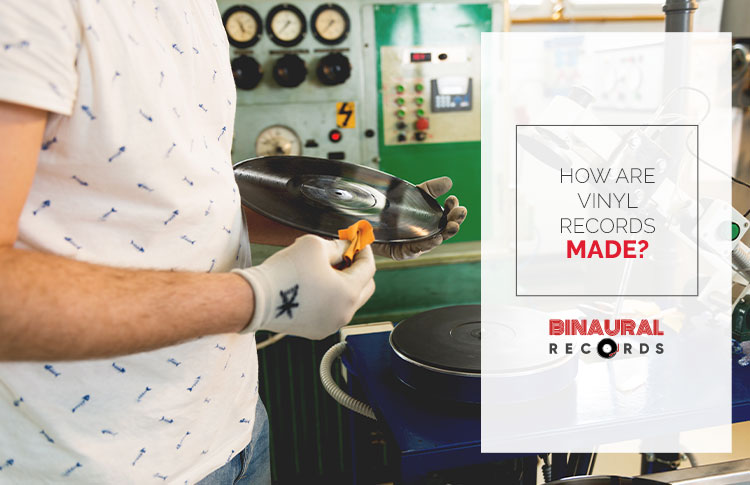
The Process of How Vinyl Records Are Made
A fun party trick is to collect a bunch of innocuous facts about random crap and then drop it whenever is convenient. For example, did you know that before the Grateful Dead and Velvet Underground settled on their respective names in the mid 60s, they both had the same original band name? For real. Each band went by The Warlocks. Then, sometime in the mid 60s, each group learned independently from the other that there was another band of the same name on the opposite coast, so both decided to change their names — and both would then go on to change music forever. Funny how life works like that, eh?
Anyway, enough rambling about factoids, the point of this article is to give you some more ammunition in the party fact trick category. Let’s outline exactly how a vinyl record is made.
Recording, Mixing, And Mastering The Tracks
Everything begins in the studio, where musicians record music with a sound engineer over a period of time. This can take place over a day, or two, or weeks, or even longer. These days, almost all recordings are tracked digitally into a computer. In the past, they’d be recorded on analog tape. The latter is still done from time to time, but typically with specific musicians who have a very specific vision (and large budget). Imagine this as shooting photographs with your sophisticated iPhone versus an old 35mm film camera. The film camera can produce some one of a kind results, but you really have to know what you’re doing.
Next, a producer mixes the tracks — taking all the different tracks recorded and blending them together, sometimes adding effects like compression or reverb to get them to an ideal state. Mixing can transform raw and dry records into full-sounding, balanced songs. This process can take a varied amount of time depending on the project. The most important thing to remember is that producing requires a special ear, usually one with experience. In other words, there’s a reason that people like Rick Rubin — widely considered to be one of the greatest living music producers — have massive houses in places like Malibu.
Once that artistic vision is achieved, the songs are then mastered, converting them into their final form that will be distributed. Usually, mastering will involve balancing the volume and equalization on the tracks so that they sound consistent over the entire recording. Even on entire albums, most artists choose to have a stable sonic footprint from song-to-song. It’s also worth noting that genre of music plays a role in this process, as well. It might seem obvious, but mastering a rap song is a bit different than mastering an indie rock ballad.
Mastering also takes into account the final medium for the music. Songs and albums that will be played on vinyl have to be mastered differently than those played digitally on streaming services or CDs. Vinyl is analog, meaning the audio file is played by continuously reading it and translating it into an electrical signal (which then gets amplified by a stereo system). Particularly at low frequencies, this process can distort and “smudge” sounds together, giving vinyl its characteristic warm sound. Vinyl is less “exact” than digital recordings, which encode sound very precisely at all frequencies but often sound cold and harsh as a result.
Once the tracks have been recorded, mixed, and mastered for vinyl, they’re ready for their first press.
Creating A Master Copy
Once they’ve been optimized for vinyl, the master files now need to be converted into a physical master copy. A lathe is used to imprint the digital song files onto a plastic lacquer plate. This is done using a heavy stylus, encoded through a digital-to-analog converter. As the song files are read digitally, the signal is converted to analog to control the pressure on the stylus as it carves grooves into the lacquer. Each side of the record gets its own plate, since the grooves on each side are different. Once the plates have been created, we now have a physical copy of the record. We could even play it on a record player and it would sound normal. However, the plastic will wear down quickly, and is still too fragile to make many copies for distribution. Instead, the lacquer plates are sent to a processing plant for electroforming.
Electroforming
Electroforming (also known as electroplating) creates robust metal copies of the lacquer master that will be used for pressing the records. The lacquer plate is sprayed with a thin coat of silver, and then immersed in an electrically-charged chemical bath. Over time, metal builds up on the surface of the record. It is then immersed in another bath with a greater electrical current, causing much of the metal to build up. The metal from the baths now has ridges in the exact fitting shape to the lacquer master’s grooves.
Moving forward, there are two directions to go to finish creating vinyl records, the One Step Process and the Three Step Process.
In the One Step Process, this metal plate can now be used as a stamper to imprint these grooves into a few hundred copies of vinyl. However, it won’t last much longer than that.
In the Three Step Process, the metal disc is not used as a stamper, but rather, is electroplated again to form another inverse part, this time with grooves instead of ridges. This new part is called the “mother” (Danzig voice). The mother can be used to electroform additional plates with ridges, creating as many stampers as desired. Usually, processing plants will make one stamper per 500-750 records.
Now that we have a durable metal stamper, it’s time to actually press the record.
Pressing
The stampers have ridges corresponding exactly to the grooves of the record’s final products, so all that needs to be done is to press those ridges into vinyl to create records. This is what we call “the fun part.”
First, polyvinyl chloride is heated up to a few hundred degrees and pressed in an extruder to create a hockey puck-shaped disc, called a “biscuit.” The record labels are firmly stamped onto the biscuit. The labeled biscuit is now sent to a huge hydraulic press. The vinyl is sandwiched between the metal stampers and pressed at over 2,000 pounds per square inch of pressure to firmly imprint the grooves.
The excess is cut off the sides and, boom, the record is finished.
Still, some records will be sent through a few quality control steps to ensure they still sound like the original master. Even microscopic amounts of dirt, dust, or scratches on the lacquer master or stampers can lead to large sound problems in the finished product.
Quality Control
Once they’ve been pressed, a small batch of test records are given to the artists and labels for review. This will be the final opportunity to evaluate how the audio sounds before a larger production run. If approval is given, the plant will then go into production.
Even after a successful test-pressing, many records will still have defects that make them unusable when pressed. During production, records will be randomly pulled for thorough audio and visual inspection by an experienced vinyl technician. With rigorous quality standards, as many as 10-20% of these records will not pass the inspection. These guys know how to grade records, heh. (Worth noting that the vinyl from discarded records is not lost forever — it can be reused, reheated, and recycled to make new records at a low cost).
Packing In Sleeves
After the records pass the quality control check, they are stored on spindles which keep them flat and help with curing before packed up into sleeves and album covers, eventually making their way to a record store (like Binaural) and onto your turntable. We hope you enjoy explaining this process to your friends when all they want you to do is put on your new copy of Powerslave.







